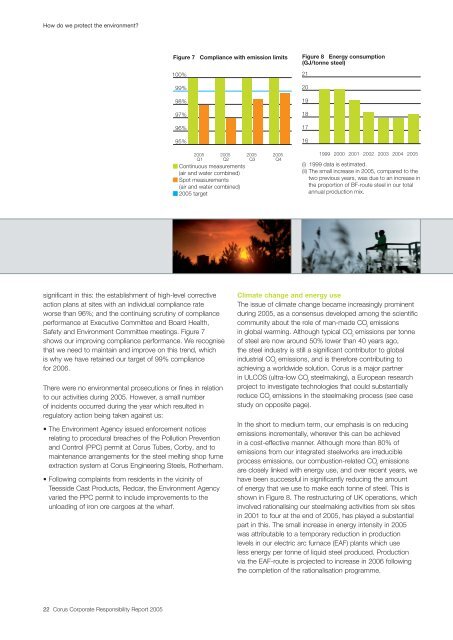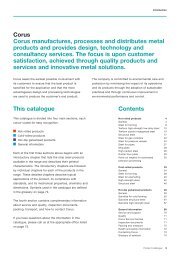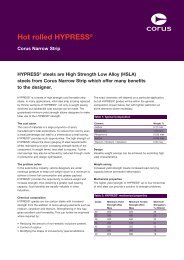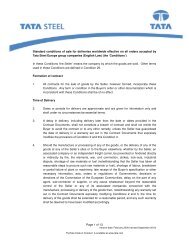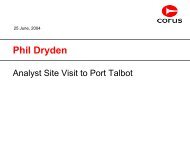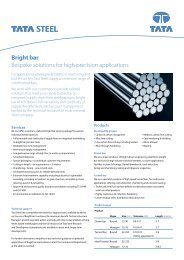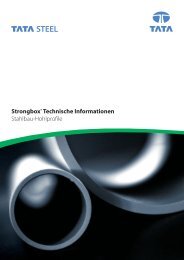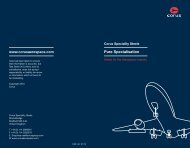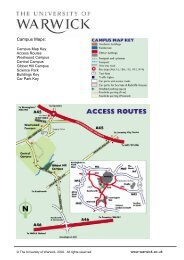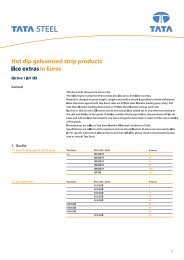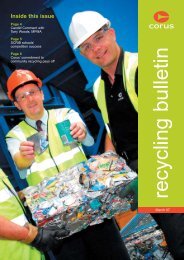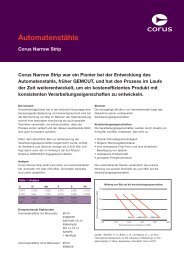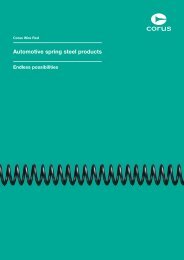Corporate responsibility report 2005 - Tata Steel
Corporate responsibility report 2005 - Tata Steel
Corporate responsibility report 2005 - Tata Steel
Create successful ePaper yourself
Turn your PDF publications into a flip-book with our unique Google optimized e-Paper software.
How do we protect the environment?<br />
Figure 7 Compliance with emission limits<br />
100%<br />
99%<br />
98%<br />
97%<br />
96%<br />
95%<br />
Figure 8 Energy consumption<br />
(GJ/tonne steel)<br />
21<br />
20<br />
19<br />
18<br />
17<br />
16<br />
<strong>2005</strong><br />
Q1<br />
<strong>2005</strong><br />
Q2<br />
■ Continuous measurements<br />
(air and water combined)<br />
■ Spot measurements<br />
(air and water combined)<br />
■ <strong>2005</strong> target<br />
<strong>2005</strong><br />
Q3<br />
<strong>2005</strong><br />
Q4<br />
1999<br />
2000<br />
2001 2002 2003 2004 <strong>2005</strong><br />
(i) 1999 data is estimated.<br />
(ii) The small increase in <strong>2005</strong>, compared to the<br />
two previous years, was due to an increase in<br />
the proportion of BF-route steel in our total<br />
annual production mix.<br />
significant in this: the establishment of high-level corrective<br />
action plans at sites with an individual compliance rate<br />
worse than 96%; and the continuing scrutiny of compliance<br />
performance at Executive Committee and Board Health,<br />
Safety and Environment Committee meetings. Figure 7<br />
shows our improving compliance performance. We recognise<br />
that we need to maintain and improve on this trend, which<br />
is why we have retained our target of 99% compliance<br />
for 2006.<br />
There were no environmental prosecutions or fines in relation<br />
to our activities during <strong>2005</strong>. However, a small number<br />
of incidents occurred during the year which resulted in<br />
regulatory action being taken against us:<br />
• The Environment Agency issued enforcement notices<br />
relating to procedural breaches of the Pollution Prevention<br />
and Control (PPC) permit at Corus Tubes, Corby, and to<br />
maintenance arrangements for the steel melting shop fume<br />
extraction system at Corus Engineering <strong>Steel</strong>s, Rotherham.<br />
• Following complaints from residents in the vicinity of<br />
Teesside Cast Products, Redcar, the Environment Agency<br />
varied the PPC permit to include improvements to the<br />
unloading of iron ore cargoes at the wharf.<br />
Climate change and energy use<br />
The issue of climate change became increasingly prominent<br />
during <strong>2005</strong>, as a consensus developed among the scientific<br />
community about the role of man-made CO 2<br />
emissions<br />
in global warming. Although typical CO 2<br />
emissions per tonne<br />
of steel are now around 50% lower than 40 years ago,<br />
the steel industry is still a significant contributor to global<br />
industrial CO 2<br />
emissions, and is therefore contributing to<br />
achieving a worldwide solution. Corus is a major partner<br />
in ULCOS (ultra-low CO 2<br />
steelmaking), a European research<br />
project to investigate technologies that could substantially<br />
reduce CO 2<br />
emissions in the steelmaking process (see case<br />
study on opposite page).<br />
In the short to medium term, our emphasis is on reducing<br />
emissions incrementally, wherever this can be achieved<br />
in a cost-effective manner. Although more than 80% of<br />
emissions from our integrated steelworks are irreducible<br />
process emissions, our combustion-related CO 2<br />
emissions<br />
are closely linked with energy use, and over recent years, we<br />
have been successful in significantly reducing the amount<br />
of energy that we use to make each tonne of steel. This is<br />
shown in Figure 8. The restructuring of UK operations, which<br />
involved rationalising our steelmaking activities from six sites<br />
in 2001 to four at the end of <strong>2005</strong>, has played a substantial<br />
part in this. The small increase in energy intensity in <strong>2005</strong><br />
was attributable to a temporary reduction in production<br />
levels in our electric arc furnace (EAF) plants which use<br />
less energy per tonne of liquid steel produced. Production<br />
via the EAF-route is projected to increase in 2006 following<br />
the completion of the rationalisation programme.<br />
22 Corus <strong>Corporate</strong> Responsibility Report <strong>2005</strong>


